 |
| The streets of Zimbabwe's capital city - Harare |
If '
to blog' means to record a personal opinion then by rights an opinion is moot in every post. Even so, this post has been particularly difficult to write, not for lack of material, but because it's important & it's difficult to resist an angle without inherent bias. I've said before that I detest the '
..and then we went there & then we did this report..' which births an imagination stillborn. That said, applying a spin on an angle denotes a twist.. As spin-doctor author of these tales perhaps I tell a twisted story? Either way, whilst I abhor politics in all its forms, Zimbabwe more than any begs restraint. It's easy to get neck-deep in
the proverbial, sprouting
the proverbial, for the sake of stirring opinion.
First-time visitors to Zimbabwe will ponder the conundrum of an infrastructure in quiet decay, juxtaposed, in some cases, by ultra-modern buildings, almost always correctly positioned on the dragon's back.
Streets yell out as vehicles veer around pocked reminders of yesteryear, when clean-paved infrastructure was a nation's pride. Buildings sag under a hint of painted alabaster, long lost under Africa's unrelenting
sons. The nearby ICBC reflects a new dawn.
 |
| A travesty - trees are tortured by fire until they fall |
Let's talk bias, for context, rather than as an expression of an echoed
shout at the devil who has no ears.
First off, Zimbabwe's peoples, particularly in the west and the far north, face an uncertain future. Commercial land lies fallow or is farmed by
subsistence policy
; an
ineffective agenda by most definitions of the word
hunger.
The
World Food Program [WFP], a UN sponsored initiative, delivers food to remote villages where villagers find it impossible to keep the wolves at bay. In the Zambezi Valley, now ear-marked for unheralded influx-settlement, marginal lands cloak the people in a perpetual coat of dust; or an unforgiving seasonal mud. In the south ranch-land lies barren. Where 50000 head of family beef once roamed alongside
lion & elephant, goats currently bleat. In the East disheveled mansions, squat & roofless, are home to rats & night-crawlers. Toll-booths demand their $. Touts play havoc at the borders & foreign visitors tread in dread.
 |
| Crake Cottage - Harare |
Paradoxically, in most cases, the rural Zimbabwean, off the beaten track, is confidingly hospitable. These gentle folk, imposed upon, often ignore the concept of self-preservation & are prone to offering fare, scratching in the beleaguered dust, for the foreign visitor's chance at rural immortality. By comparison, the commonplace facilities, on the beaten track, extract $s in a mean-spirited, gnarly sort of way, perhaps against a time of reckoning in the not too distant future.
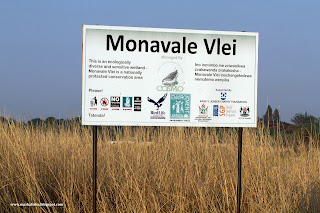 |
| How long? |
As for the shelves the SA Retailers froth to earn a $ even if, arguably, at exploitative prices. The
Vervaardig in Suid Afrika [Made in South Africa] stamp of approval, on most goods, lends a taste of home & makes mealtimes, pleasant.
 |
Variable Sunbird - a common resident at Crake
|
Although Monavale Vlei is currently under local lock & key, the fate of Borrowdale isn't as benign .. South Africa's
McCormick Property Developers will / are building a $100m mall on what was once a protected wetland. You have to question the foresight, logic & perhaps even feel a little bemused, if not ashamed, at the alacrity SA retailers including Pick'nPay, Spar, Game, Forchini, Mr Price & Woolworths availed themselves of the new concrete space. Lip-syncing green on the JSE & in the fashionable rags is a croak against the gods and an insult to future generations. What price a nation's soul? $100m is nothing more than an insignificant sum of money.
Our whistle-stop tour had three distinct & aesthetically divergent legs. At face value this is why Zimbabwe ranks as one of, if not the more scenically original & biologically diverse countries in the sub-region. The first birding
biome we sought out were the
miombo forests in & or close-enough to Harare for a number of the
miombo specials.
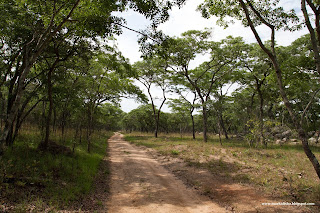 |
Gosho Park [Peterhouse Girls School] - Marondera
|
Whilst Harare is a birder's haven we prefer Marondera's Gosho Park, a touch further afield and currently under the care, control / management of Peterhouse Girls. Before I get to Gosho a few lines on Harare. Most birders visit Harare in the correct season ie: January - March when the local vleis / dambos [wetlands] are sufficiently wet to attract the migratory wetland rarities. We were clearly too early or too late depending on how you view the glass. Even so, the dry wetlands are currently home to thousands of Abdim's Stork & an unusual irruption of African Cuckoo Hawk. If nothing else we're a curious bunch & in lifting the lid of the cloche we
beheld a sea of locusts, an early season
hors d'oeuvre for the local residents before the guests arrive. Later that evening our Guesthouse garden was seemingly declared an impromptu hexagon for two displaying Pennant-winged Nightjar who serenaded us with their trills of competition & for most the night; a welcome distraction from the whinging & whining of the local mosquitoes. Their ladies are clearly a fussy bunch..
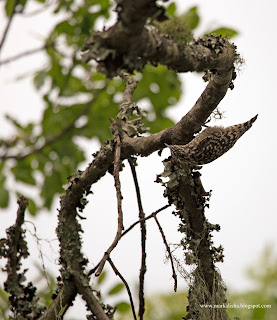 |
Miombo special - Spotted Creeper
|
Gosho Park is a must-visit. It's clean, safe & pristine. Birds appreciate these efforts too & throng to the miombo for its local offerings. Finding the birds is not as difficult as the guide-books suggest. Pay the gate-keeper, join a bird-party & as sure as I've never met Heidi Fleiss in the flesh, the birds reveal themselves. We recorded Wood & Tree Pipit, Cabanis's Bunting, Miombo Rock Thrush & most of the other locals apart from two tits; Miombo & Cinnamon-breasted. The three stand-out heroes of the day were Spotted Creeper (2 adults feeding two chicks), Collared Flycatcher (photographed) & the region's 19th Eurasian Blackcap which I missed from a long stone's throw away whilst capturing the Collared Flycatcher.
As a side note & on the issue of photography, our long lens was damaged on Day 2 & was sent home for repairs. This particular post, therefore, has fewer bird images than might have been the case under
normal conditions even though bad weather, most days, played havoc with the light. The Blackcap was particularly galling for three reasons. One, it would have been a lifer for every member of our party. As I write this it's no longer a lifer for every member of my party other than for yours truly.. Two, we can't include the bird in our 800 Challenge, both of us have to see the bird for inclusion & what an inclusion it may well have been! Three & the most galling of all, my
dearest & fairest smiles serenely & almost always in my general direction, without any notable signs of remorse, whenever the question of '
leading twitcher in the Familia' is raised around the dinner table. Even the far-off
probable / maybe / might have / please let it have been Amsterdam Albatross which I saw & my dearest 'sadly' missed, is no longer fair exchange. Any mention of this rather important point gives rise to howls of derision, a personal affront from which I might never recover.. Damn birds!
 |
| Not quite the rainy season but weather proved difficult |
 |
| Screen shot - Zambezi Valley map (Crake round-table) |
The second leg involved a journey to the much drier far north but not before a round-table discussion with Crake Cottage hostess, Dorothy Wakeling. Two points of interest emerged from our discussions. The first & the most telling was the patience & almost ephemeral grace of our hostess, who like many others, had to make do with very little infrastructural support. It is to people like these to whom we, as visitors, should give credit. Yes we had no hot water & no it isn't cheap, even by 1st-world standards, but the breakfast (x2) was superb & that's usually good enough for me.
The second interesting tit-bit from our discussions was clearly the more taxing. The road north, an inconsequential 300 km on the map, would be difficult, very difficult; 7 hours difficult. Whilst Dorothy was at pains to point out the defining features on her map, if it wasn't for the capable assistance of Louis Heyns, who provided us with waypoints prior to our departure, we would certainly, as we speak, still be suffering under the yoke of the Tsetse Fly somewhere in the Zambezi Valley.
 |
| Community campsite - Masoka Village |
 |
| Leaf litter - Masoka [In search of African Pitta] |
As it was we hovered on the abyss & succumbed to doubt in the latter half of the 7th hour. We almost turned back. If obstinance has a persona then Alisha is its master...with respect & permission. It was, as a consequence, an angel-sung chorus of relief when we arrived at an unmarked Masoka Camp, 3 clicks west ('
approx.' - love the associated confusion) of Masoka Village & to some unexpected but wholly familiar faces. Etienne Marais, leading a guest on a photographic journey through the sub-region for the specials, had beaten us to this African Pitta paradise with a day to spare. If Dorothy's the SA contact in Harare then Mackenzie Zirota is the equivalent in the far north. He is, undeniably, the pitta whisperer & even though we spent the next 48 hours on hands & knees & in the deepest crud south of the Zambezi we were, in the end, rewarded with fair to middling views of the African Pitta, a difficult bird & the reason we had come this far north. Along the way we picked up Red-throated Twinspot, Thick-billed Cuckoo & the other notable special in the area, Lillian's Lovebird.
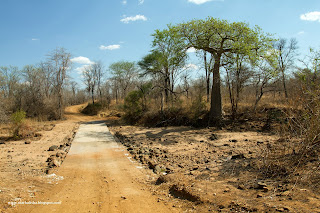 |
| Bridge over the river Angwa |
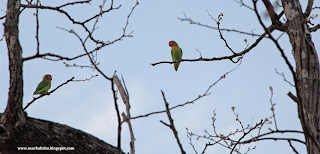 |
| Lillian's Lovebird - near Chewore |
A quick word on the community & Masoka in general. It's trite that the community does its best to live off the land. Along the way these hardy people contend with erratic weather & the nutritional demands of raiding elephant which find cultivated crops simply irresistible. However, it's the less obvious obstacles, posed by infrastructural deficiencies, that make life interesting, if not a tad tiresome. One such example are the many seasonally-dry river beds visitors / residents have to cross
en route the village from Angwa Bridge, the last hurrah of infrastructural glory an hour back in time. In the dry season crossing the sandy beds is relatively simple. In the wet-season, however, crossing these flash-flood torrents is another kettle of kapenta altogether. Whilst most deep-pocket visitors engage automated mud-terrain programs & or low-range, largely relying on the engineering prowess of professionals many thousands of educated hours away, locals don't always have that luxury. Yes outsiders can communicate with local residents on Facebook, the internet or by cell-phone; another exploitative story for another time, but food, critical to the success of the community, cannot be teleported across the airwaves. Once Amazon gets it's delivery-drone program up & running this too might change but, until then, trucking the food into the area is still the only viable option open to the people.
Here's where it gets interesting. An international
bridge-building NGO roams rural Africa teaching the skills associated with medium to heavy engineering, thus opening up areas previously uninhabitable. The entire community, less school-going children, education is important in Zimbabwe, turned out at one particular ford to set right about the weather gods and started work on a new concrete bridge. As an interested rubber-necker it was fascinating to watch the chain-gang collect, mix & pour concrete in a manner almost musical. Community-project productivity is, in rural Zimbabwe at least, nothing short of impressive.
 |
| Aberfoyle Tea-estates |
Our third & final
country-within-a-country was the Eastern Highlands, an area infamous for its teas, forests, mist, winding mountain passes & birds altogether uncooperative. From Nyanga to Chimanimani, Vumba in between, this area is undeniably Zimbabwe's crown jewel. As always we needed more time, fewer roadblocks, less challenging road conditions, more suitable accommodation & better weather. Other than that we had a blast.
 |
| Seldomseen - Vumba [Eastern Highlands] |
I do, however, have the barest of suspicions that some of the specials claimed common in this area are figments of the imagination but then, as a legal-hound, I'm suspicious by nature.. Lesser Seedcraker springs to mind but that too is a story for another hour.
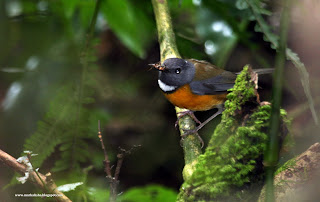 |
| Vumba special - Swynnerton's Robin |
 |
| Vumba Botanical Gardens |
Throughout our adventure we've faced challenges which, at inception at least, were left largely unplanned. One of the more pertinent reasons we set out on this challenge was to do exactly that; challenge ourselves. That includes, in our case & most importantly, finding the time to travel the sub-region extensively enough to make good on the accounting aspects of the challenge ie: get to 800. In addition, three teen-aged, school-going children add sufficient spice to the mix to make a twitcher's eye water. Our eldest daughter, Amber, studying O-levels through the UK by correspondence, has by virtue of the associated flexibility, joined us on all our trips bar two pelagics. As a 16 year-old her list for the year is notable.. Our other two children are mainstream students, confined to the classroom & therefore largely sedentary, which makes travel
rough & tough. Given these constraints our time away is usually woefully short. Birds targeted become a lottery of more is better. Return visits are whispered luxuries if not logistically impossible. Dipping on Bronze Sunbird therefore, confined largely to this area, was particularly annoying but that's how an adventure of this nature unwraps over time. Paying the equivalent of R1000 for five pieces of cake and a chosen brew each, at Tony's Coffee Shop, was equally
'amusing' & a scandalous affront to my Scottish ancestry! The Swynnerton's Robin, however & the other local specials, inclusive of Red-faced Crimsonwing, we safely stowed away.
If pictures claim a 1000 words then the Highlands, in the east, are the merest rung or two below the promised land & if green reminds you of a peaceful time then Zimbabwe scores a 10.
 |
| The 'Old lady' - Leopard Rock Hotel |
Even so, behind this mirage lies an equal truth. This country needs assistance. Her people cry out & her colours fade. The Vumba Botanical Gardens & the 'Old lady' close-by are jaded bastions of a time long past when love & money guarded the country's pride in tangible things. Today this once 'Globally commended, Top 100' golf course lies unseeded, uncut & sadly in a state generally unbecoming. The Botanical Gardens display hints of care but have largely become clogged with stubborn weed, undergrowth & a laissez faire attitude to investment of resource & time. It's sad. It's real & it's true. Anything else is twisted propaganda.


















Russian Escorts in Hyderabad
ReplyDeleteCollege Girls Escorts in Hyderabad
Foreigner Escorts Hyderabad
VIP Foreigner Escorts Hyderabad
Call Girls Services in Hyderabad
Russian Call Girls Hyderabad
Russian Call Girls
Russian Escorts in Hyderabad
high class Celebrity Escort Hyderabad
Call Girls Services in Hyderabad